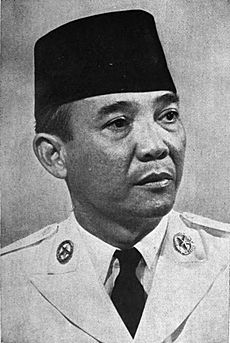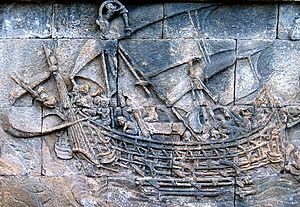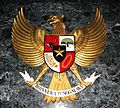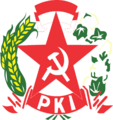History of Indonesia facts for kids
The History of Indonesia or more precisely of the Indonesian archipelago in South East Asia with 17,508 islands goes back to Homo erectus (popularly known as the "Java Man"). There have been found fossilised remains of about one million years ago.
Austronesian people, who form the majority of the modern population, came to South East Asia from Taiwan. They arrived in Indonesia around 2000 BC. The native Melanesian peoples went to the far eastern regions. The agricultural conditions were very good. When wet-field rice cultivation was developed as early as the eighth century BC, villages and towns developed, and small kingdoms began to flourish by the first century CE. Indonesia's sea-lane position helped with management of international trade, where trade with both Indian kingdoms and China already occured for several centuries BCE. Therefore, trade has since fundamentally shaped Indonesian history.

From the seventh century CE, the powerful Srivijaya naval kingdom flourished as a result of trade. Hinduism and Buddhism were imported with it. In the late 13th century, the Hindu Majapahit kingdom was founded in eastern Java and under Gajah Mada, its influence stretched over much of Indonesia; this period is often referred to as a "Golden Age" in Indonesian history.
During the 13th century Islam spread to the in northern Sumatra. More and more Indonesian areas gradually adopted Islam. By the end of the 16th century it was the dominant religion in Java and Sumatra. But it mixed with existing cultural and religious influences.
The first Europeans arrived in Indonesia in 1512, when Portuguese traders, led by Francisco Serrão, sought to monopolise the sources of nutmeg, cloves, and cubeb pepper in Maluku. Dutch and British traders followed. In 1602 the Dutch established the Dutch East India Company (VOC) and became the dominant European power. But Dutch control stretched not very far. Only in the early 20th century it extended to borders of today.

During the Second World War the Dutch lost control and in August 1945, Sukarno, an influential nationalist leader, declared independence and was appointed president. After some fights the Netherlands formally recognised Indonesian independence in December 1949 (with the exception of The Dutch territory of West New Guinea).
Sukarno moved from democracy towards dictatorship. But Sukarno lost power to the head of the military, General Suharto who was formally appointed president in March 1968. He was supported by the US government, and encouraged foreign direct investment in Indonesia, which helped economic growth during the following thirty years. But his rule went along with corruption and suppression of political opposition.
In 1997 and 1998, Indonesia was the country hardest hit by the Asian Financial Crisis. This increased popular discontent with the New Order and led to popular protests. Suharto resigned on 21 May 1998. In 1999, East Timor voted to leave the state of Indonesia, after a twenty-five-year military occupation. After Suharto's resignation democracy improved. A regional autonomy program was introduced, and the first direct presidential election took place in 2004. But some political and economic instability has remained. A political settlement to an armed separatist conflict in Aceh was achieved in 2005.
Images for kids
-
1600-year-old stone inscription from the era of Purnawarman, king of Tarumanagara, founded in Tugu sub-district of Jakarta.
-
8th century Borobudur Buddhist monument, Sailendra dynasty, it is the largest Buddhist temple in the world.
-
Prambanan in Java was built during the Sanjaya dynasty of Mataram Kingdom, it is one of the largest Hindu temple complexes in Southeast Asia.
-
Batavian (Jakarta) tea factory in the 1860s.
-
Japanese bicycle infantry move through Java during their occupation of the Dutch East Indies
-
Sukarno speaking at the Rapat Akbar (grand meeting) on 19 September 1945.
-
Suharto was the military president of Indonesia from 1967 to 1998.
See also
 In Spanish: Historia de Indonesia para niños
In Spanish: Historia de Indonesia para niños























